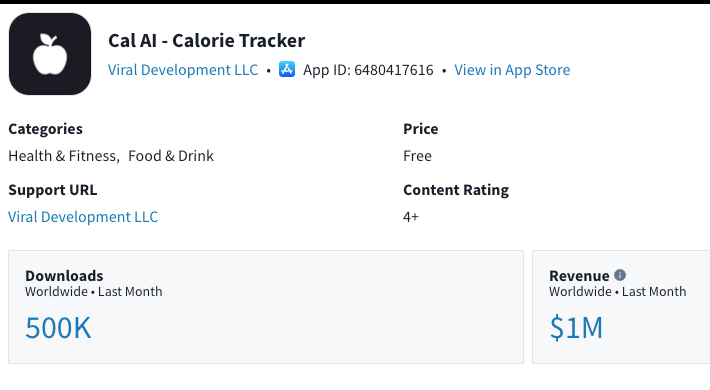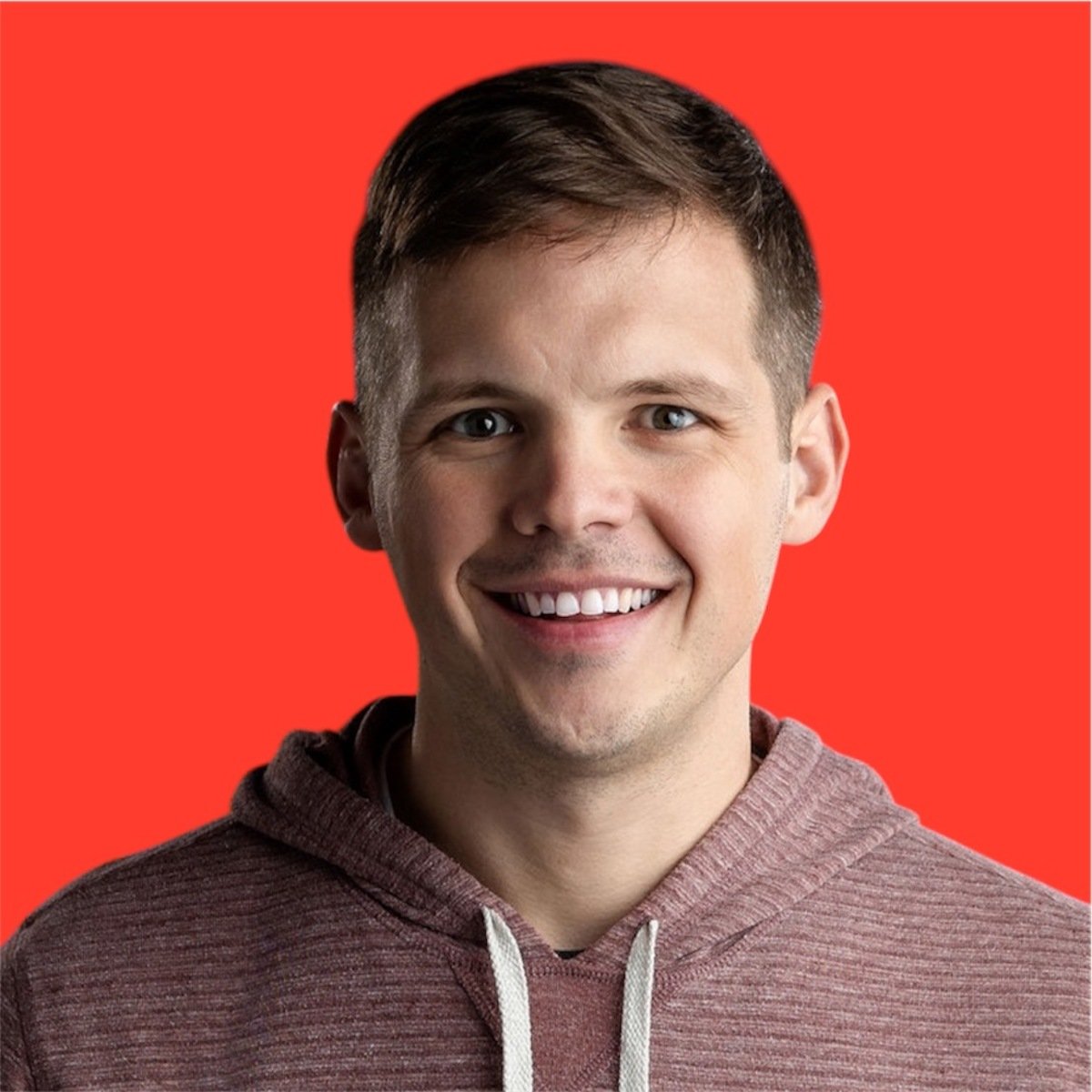Good morning!
I’m 4 days late in sending today’s newsletter, because this one took so much time to research! I wish I could tell you I just used deep research or some other AI tool to write this but…not even close. It definitely helps for aggregating research, but it’s not even close to mimicking my writing style, or even writing like a normal human.
AI wrapper this AI wrapper that…I’ve mentioned that a lot lately, yeah? That’s because I think it’s one of the world’s greatest asymmetric bets right now!
Speaking of, if you didn’t see my recent interview with the founder of the AI call answering service, Rosie, definitely check that out!
But there’s another poster child of the AI wrappers that goes by the name of Cal AI.
Cal AI is a calorie tracking app that launched 11 MONTHS AGO and hit $1 million in MONTHLY RECURRING REVENUE their first 7 months!! In one of the most crowded spaces known to man…
But before we get into that, a couple housekeeping items of business:
Also, I want to start traveling to do meetups with you all. Below are the cities with the most people that listen to my podcast. Are you in one of them? If so, please vote. Or vote "Other” and then tell me the city after voting.
What city do you live in or near?
This way, if I do have an event or meetup in your city, I won’t have to spam everyone on this list about it!
Ok, back to today’s newsletter.
Cal AI seems different or unique on the surface because you can track calories simply by taking a picture of your food but guess what? That isn’t new or unique! It’s been around forever. It’s “just” an AI wrapper.
Oh, and the founders were 17 years old.
In case you don’t know, calorie tracking apps are about as common as goldendoodles at the dog park nowadays.
So how in the world did a 17 year old-led boring old AI wrapper hit $1m in MRR within a few months? Well…keep reading my friend.

What I love about these founders is that they tried a bunch of stuff. But the tactic that worked best for them was manually DMing influencers and getting them to post simple videos like these. And they didn’t give up after a couple DMs. They kept going and going and going…That ALONE made them stand out (this is coming from someone who gets these DMs, too).
And what a framework:
Find a market that is already a MASSIVE short form niche (food)
Build a SaaS tool that enables people to seamlessly demo your product in a non spammy way
Manually DM a zillion micro influencers with very loyal followings
Use AI to build said product
Their product hunt launch was a dud (which gives me hope, because most are).
The set the price low to help encourage mass adaption. $9.99 per month or $30 per year. And no freemium plan. 100% of users had to pay up from the start.
3 months in and they were at $500k in MRR. A couple months later? $1m. And the vast majority of this came from influencers and micro influencers simply posting pictures of their food and showing HOW they tracked calories.
By the end of 2024 (7 months in) they had 150 influencers posting regularly about Cal AI. Just think of how powerful that is…
Cal AI set an optimal cost target of ~$5 CPM (cost per thousand views) for these campaigns. So if an influencer regularly gets 100k views per video, they’d offer them $500 for a video. At a $100 lifetime value per customer, they only need to acquire 5 customers from a 100k view video to break even. They’d likely get 5 - 20x that.
By the end of 2024 they started putting $7k/day into paid ads across Meta and Tiktok. And here’s the genius part - they knew exactly which creative to use for their paid ads because by this point they had thousands of examples of winning videos from their micro influencers.
How genius is that? Let the algorithm tell you which organic content is “viralable” and then push paid ads behind the winners.
THIS IS LITERALLY A CHEAT CODE TO ACQUIRING CUSTOMERS! I am doing it myself. Some of you reading this got here because I took one of my viral videos, put some money behind it and pushed it to a larger audience at a cost of $1.18 per subscriber.
Speaking of Meta, how’s that for meta?
But they weren’t done with paid ads yet…they started pouring cash into Apple Search ads. So if someone searched for MyFitnessPal on the app store, they’d see Cal AI.
When your app has 50% net margins, you can afford to pour cash into ads!
The genius, first principles reason that this app has done so well is due to habit stacking,.
The app was integrated into the daily lives of its users. Every freaking time they take a bite of a meal or snack they have to use the app. That makes users LOYAL, STICKY, AND BRAND AMBASSADORS. OF COURSE their friends ask them why they’re taking pics of their food! And of course they tell them about Cal AI!
Most viral apps are a flash in the pan because they aren’t integrated enough into their users’ lives.
Speaking of retention, Cal AI’s onboarding flow is another clever aspect of their growth mechanics. When new users sign up, the app asks personalized questions about their weight goals, lifestyle, and motivations. This does two things: it tailors the user’s experience, and it makes the user emotionally invest in the outcome. By prompting users to reflect on their goals (say, “Why do you want to lose weight?”), Cal AI creates a personal connection that can increase the commitment to using the app.
If I had to distill down to only 7 core reasons why they were successful, it’d be these:
Micro Influencers: Cal AI messaged thousands of small creators. They helped these creators make videos go viral, acting like their own growth team.
TikTok Hack: Zach made new TikTok accounts focused only on fitness. This let him find popular creators fast and free.
Show, Don’t Tell: Ads quickly showed the app in action—snap a photo, get calories. Viewers saw value instantly.
Rewarding Influencers: Creators earned money when their followers signed up, making them push the app even harder.
Cheap, Not Free: Cal AI didn’t offer a free version. They charged $30/year right away. This got them fewer users but better ones who paid quickly.
Small Team, Big Results: AI handled lots of work like messages and customer help. With just 12 people, they made $1M a month.
Easy and Personal: Simple questions when you start made users feel connected. Easy design kept users happy, so they kept using and sharing the app.
So what now? Go start tinkering with building some AI apps on Replit, Cursor, Lovable, Bolt, etc. It’s never been more accessible!
If you want to dive even deeper on Cal Ai’s growth story, the best YouTube interview I found of the founder is here, but I’m working on getting him on my pod as well!
There’s also a good case study on them here, but it’s paywalled.
Speaking of accessible businesses, I interviewed the founder of HL on today’s podcast and asked him “what are your most successful users doing to build 6-8 figure businesses on HL?” And he answered! Listen below:
Thanks for reading!
Chris Koerner
TKOPOD.COM
